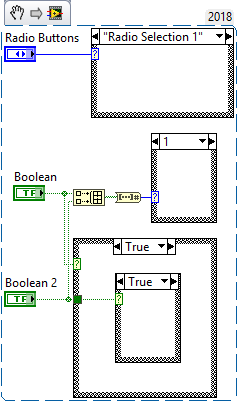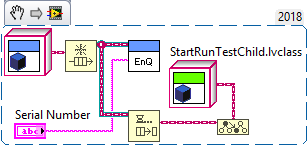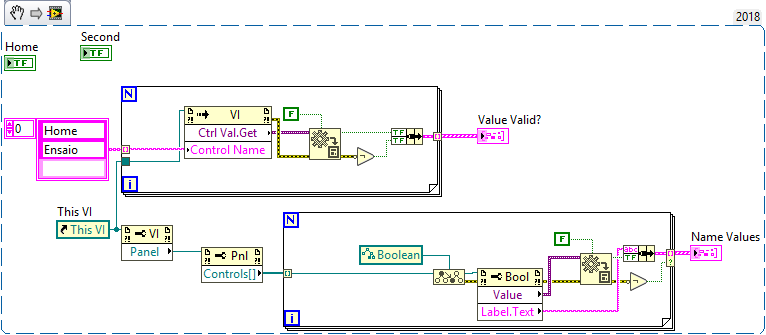
infinitenothing
-
Posts
372 -
Joined
-
Last visited
-
Days Won
16
Content Type
Profiles
Forums
Downloads
Gallery
Posts posted by infinitenothing
-
-
Are you setting verify to "false"? The verify server input is for using client certificates. I don't think you need it if you are connecting to a public site. I believe in that case, the function will verify with public CAs instead of using your client cert.
-
Recert by points always seemed like too much accounting effort. I'd do it if there was a website where you could submit the request and have it keep track of everything.
-
Yes, what you're doing is super common. It might be worthwhile to use the TDMS file format instead of a spreadsheet file. It's a very easy format for recording and playing back data.
I'm a little curious why you're using a CRIO. It's not a bad choice but something a CDAQ could be simpler.
-
5 hours ago, ShaunR said:
I know you are looking for the most precise method for this type of waveform, but is there a reason you can't do a peak detect to remove the lead-in?
At this point, AutoCorr is working well enough and I'm just curious about the advantages and disadvantages of different methods. My signals are rather noisy so it's not always super clear how far back the "start" is from the trigger.
-
-
On 2/9/2019 at 7:45 AM, Francois Normandin said:
If you need to track frequency in a noisy realtime environment, I've seen Kalman-based filtering being used.
Unfortunately, I don't have an implementation example to provide. NI has this discrete filter in the Control Design and Simulation toolkit... which does not come cheap.Interesting. I've seen its use in things like GPS. Actually, in my particular application, I'm not tracking a frequency. There's some "dead air" which I simulated above with the zeros and then the signal which is unrelated to the previous signal. Does that rule out Kalman or am I misunderstanding how you'd use it. I have the platform suite so I think I have the control design toolkit.
On 2/9/2019 at 9:05 AM, ShaunR said:Mhmm..yeah... I know some of these words. 😉 I'll take a look at some of the algorithms they mention.
-
I tried a few different ways of estimating frequency and I thought I'd compare them. If anyone has some other ideas or links to other techniques, I'd like to see how they perform.
Techniques used the VI:
- Zoom FFT
- PSD
- AutoCorrelation
-
-
Maybe I should have tested this before I posted but if I switch Enque Serial Number to a .vim, the broken wire resolves and everything works out. Neat! I wonder if there are any unintended consequences.
-
-
I'm not clear how adding another dynamic dispatch input solves my problem. The queue ref is still statically dispatched and will only take a queue of the parent class.
In terms of intent, I'm looking to improve reuse. Rather than writing an enqueue function in each child class, I just want one VI to handle that.
-
-
-
-
Nothing sticks out to me. Have you tried the memory profiler to see what subVI is giving you problems?
http://zone.ni.com/reference/en-XX/help/371361P-01/lvdialog/profile/
-
To clarify the second image was posted before the forum update. Here's the thread:
So, I'm guessing the forum is stripping the metadata on upload now. I reposted that image in this thread by copying the link into the editor box. The box "embedded" the image for me automatically.
-
This snippet works for me:
So does this one:
-
I want to clarify that as far as I know there's no standard way to store an image in a SQLite database. That is, @Gepponline, your question has nothing to do with SQLite much less this toolkit. As far as we know, SQLite Administrator uses a proprietary binary format for storing the images as blobs. You should really go to that community to determine what that format is. Unfortunately, that project looks like it was abandoned with no source code available so you might just be out of luck.
-
The "Data Changed?" property of the action output doesn't trigger the data change event. You have to do that manually. The data change event is triggered when the control is accessed as an indicator, property node, local, etc.
-
I can't get snippets working. Did they die in the recent site update? Example:
I use the editor that shows up at the bottom of the thread and the "choose files" link. Using Chrome.
-
I suggest you break your question down into parts as different threads and forums will be able to answer each part better. It looks like your SQLite stuff is correct and your issue is just flattening and unflattening so the machine vision forum might be a better place to ask for help. In the interim, here's one way to do your flatten unflatten using the IMAQ toolkit.
-
The attached code shows how SQLite will interpret various types into an integer. It makes me a little nervous that there's no warnings or other way to determine that a value might not match what was requested. I guess I could check every value for its column type. Is there an easier way that I'm missing?
-
I believe they are in the reference array according to the tab order
You either have to know the names in advance or carry their names with their values. -










Help get QControls added to LabVIEW Core
in User Interface
Posted
I doubt there are plans to fix any of the bugs. Some of them have been going pretty much since the start.